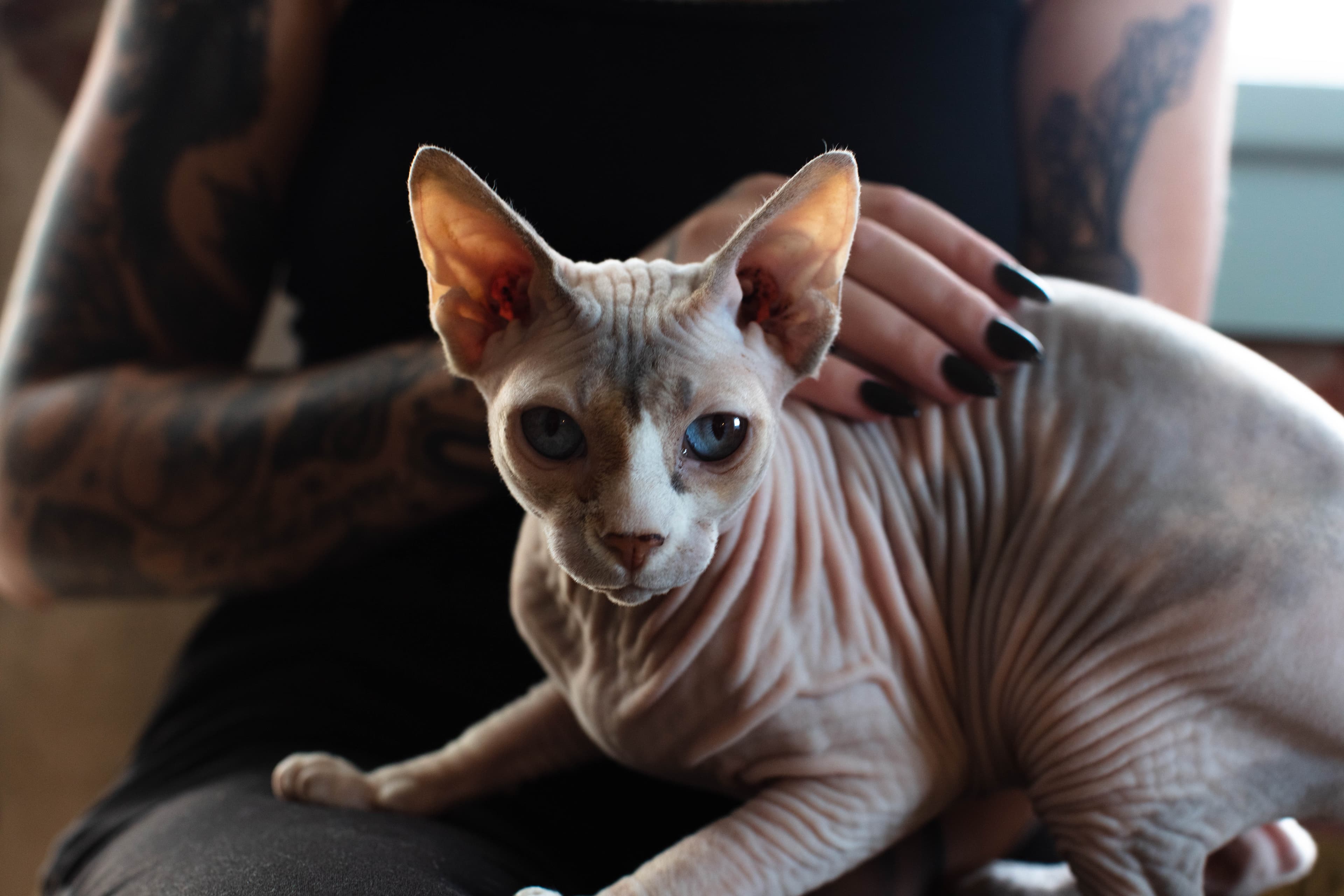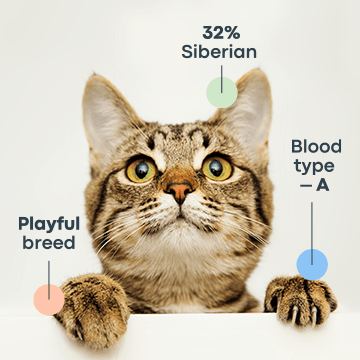Why are Sphynx cats hairless? If you have a Sphynx, you may often be at the receiving end of this question. Do you know the answer? Sphynxes are interesting cats with a unique bald look. Their lack of fur might seem unusual at first. However, this is a simple genetic mutation – nothing less, nothing more. Their loving disposition and hairless look are the perfect combo.
The Genetic Secrets of the Hairless Sphynx Cat
The KRT71 gene mutation gives this hairless cat breed its unique appearance. In particular, this leads to the absence or underdevelopment of hair follicles, thus, preventing the growth of a normal fur coat. This natural genetic anomaly has been passed down generations. Sphynxes have been selectively bred for over 50 years.
The absence of hair is not the sole effect of the gene mutation. It also has an impact on the cat's skin texture. Sphynxes don't have silky fur coats. Instead, they have smooth, occasionally slightly fuzzy skin. This fuzz is frequently compared to peach or suede fuzz. This gives them their signature velvety feel. But even though they are mostly hairless, their skin needs extra attention to be healthy and avoid oil accumulation. This is because they lack fur to absorb the oils that their skin produces.
A Brief History of the Hairless Wonder
Why are hairless cats hairless? The origin story for these felines is simple yet interesting. A spontaneous genetic mutation is behind their peculiar look. The mutation first occurred in the 1960s. In 1966, the first hairless kitty was born in Toronto, Canada. ‘Prune’ was a domestic shorthair. She carried a mutation that prevented her from growing fur. This was the beginning of the modern Sphynx breed.
The hairless trait in Prune’s descendants was carefully bred. The Sphynx cat as we know it today was born from these early breeding efforts. Initially, the breed was met with mixed reactions. Some considered the cats to be a mere genetic anomaly. But a lot of people fell in love with these pets. In the 1970s, cat registries formally recognized the Sphynx as a breed.
Are Sphynx cats natural? It is a logical question. Sphynx have been developed through selective breeding, yet, it all began with a natural genetic mutation. So in plain terms, Sphynx is a naturally occurring breed. Human intervention over the years has been aimed at enhancing the natural characteristics.
Sphynx Cat’s Unique Traits and Temperament
These bald cats have a fine layer of downy fuzz covering their skin. It gives them a unique, suede-like texture. There are many other traits that make the Sphynx different. The sky high cheekbones make this bald cat look almost regal. The sharp eyes lend a mysterious aura, as well.
Unique Physical Traits of the Sphynx Cat
The lack of fur is the most obvious feature of the Sphynx cat. Other unique physical traits contribute to the look of this naked cat. Sphynxes often have a slightly wrinkled appearance. This is more pronounced around their face and neck. These folds in their skin are one of the defining features of the breed. They appear both endearing and expressive. The prominent cheekbones and large ears add to their striking features. The almond-shaped eyes add to their “alien-like” appearance. As explained by VCA Animal Hospitals, their pixie face and batty ears are unique to this breed.
Sphynx cats are not entirely hairless though. They have a fine layer of downy fuzz. It covers their skin like they are wearing a suede outfit. Their skin is soft to the touch. Many people describe it as feeling warm. This makes them quite different from furry cats. This downy fuzz can vary in thickness from cat to cat. Some Sphynx cats may feel smoother than others.
An amazing feature is the different skin colors and patterns of naked cats. Sphynx cats come in a variety of hues and patterns. Black and white are common solid colors. But some also have intricate designs, such as spots or tabby stripes. This variety of skin color adds to the charm of the breed. It also makes sure that each Sphynx cat is unique.
Playful and Loving Nature of Sphynx Cats
These hairless cats are as playful as a feline can be. Sphynx felines are known for their immensely loving nature. These cats are not prone to hiding away in a corner. Social interaction and attention are things they actively seek out. These felines are highly affectionate. They often follow their owners around the house, seeking out companionship and cuddles.
In actuality, Sphynxes are far more loving than many other breeds. Additionally, they enjoy being the focus of attention. This indicates that they enjoy being close to their owners. These clever and inquisitive cats enjoy investigating their environment. According to PetMD, this breed is often described as dog-like. They often have close relationships with their owners and a great inclination for participatory play.
Sphynx cats and their families develop close relationships. They become real buddies with people of all ages. A Sphynx cat can be a vibrant friend as well as a loving partner.
How Sphynx Cats Get Along With Other Pets
Just watch them interact with other pets and their amiable disposition becomes evident. Contrary to what you might have heard, Sphynx cats get along with all other animals: Be it dogs, cats, or even tiny animals like mice. They like being around other animals. This is why they often initiate play and interaction. Dogs also make great companions for them. This is especially true if the canines are sociable with cats. In a household with other animals, a Sphynx will thrive. They like snuggling on the sofa with a dog or pursuing a toy with another cat.
It's important to keep in mind that individuals possess various personalities. Some Sphynx cats may be more territorial. They may feel timid around unfamiliar animals. It is advised to make gradual introductions to maintain harmony in a home with multiple pets.
Sphynx Cat Care: Unique Needs
Caring for a hairless Sphynx requires attention to their unique needs. They don’t require traditional grooming like furry cats. Their lack of fur brings its own set of challenges and care requirements.
Dietary and Exercise Requirements of Sphynx Cats
Another unusual thing about hairless cat breeds is their high metabolism. Having no fur translates to a higher metabolic rate. To stay warm, Sphynx cats burn more calories. A nutrient-dense diet is needed to maintain their energy levels.
A high-quality diet goes a long way in maintaining their protein levels. It also has healthy fats to support their energy needs. Ideally, Sphynx cats should be fed more frequently.
This ensures they receive sufficient calories to maintain their weight and overall well-being. Their fast metabolism also indicates they must remain active. Regular play and exercise are important to keep them fit and healthy.
Grooming and Skin Care for Sphynx Cats
These cats don’t have fur, which may seem like a relief when it comes to grooming, right? They still require regular care, though. For furless cats, bathing is essential. These cats produce oils on their skin. This is a normal skin function in other cats as well. Oils can accumulate on their skin since they do not have fur to absorb these oils. This in turn can cause irritation or infections. Sphynx cats need to be bathed regularly to avoid this. Once a week or every two weeks should be enough. It depends on their skin condition, so pay attention.
You also need to prevent wax buildup in the ears. Cleaning is important because they have large ears. These are more exposed to dirt and debris. And most importantly, never forget to trim their nails. Their claws should be a healthy length. A vet or grooming service can do this for you. It is an easy task, but if you are unsure, get a professional to do it.
Health and Environmental Considerations for Sphynx Cats
Being more susceptible to temperature changes is to be expected in a bald cat breed. Hot weather can easily result in a sunburn. On the other hand, they will be freezing in cold weather. A temperature-controlled environment is best for them. This is particularly true for areas with extreme temperatures. Dress your Sphynx in a sweater to help them stay warm in winter.
Regular vet checkups are a must for Sphynx cats. Heart disease, skin infections and respiratory issues can be common in these felines. Make their health a top priority.
Conclusion
Compared to other felines, Sphynx cats are unique. Despite their regal appearance, these hairless cats are tiny bundles of affection. Their distinct appearance just makes them extra special. And if that wasn’t enough, they have amazing personalities. It takes them very little time to make a place in your heart. Do not forget that hairless Sphynx cats do require extra attention. You need to focus on their grooming and health. These truly one-of-a-kind felines are worth the effort.
Frequently Asked Questions
What is the hairless cat breed called?
Sphynx is the most well-known hairless cat. Their lack of fur is the main distinguishing characteristic. They also have warm, smooth skin which feels like suede to the touch.
Why are Sphynx hairless?
A genetic mutation in the KRT71 gene gives them a hairless appearance. This is because their hair follicle development is prevented by the mutation. So a normal coat of hair does not grow on Sphynx kitties.
Are Sphynx cats hypoallergenic?
No, Sphynx cats are not hypoallergenic. Despite their lack of hair, they still produce dander and a protein called Fel d 1, common allergens in their saliva.
How long do Sphynx cats live?
Sphynx cats typically have a lifespan of around 8 to 14 years, although some can live longer with proper care and a healthy environment.




